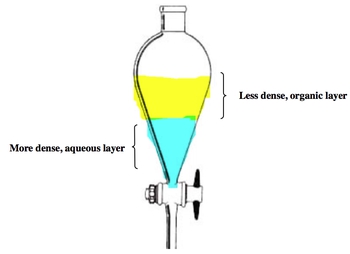Hey everyone, so in this video let's take a look at extracting. Now we're going to say under extraction we have the separation of a solid and a liquid, and we're going to say the removal of a component from a mixture is done by selective precipitation in a new solvent. Here already partially colored this in. So here we're doing extraction and here we have it with a separatory funnel. Now we're going to see that this blue portion here is the more dense liquid portion. So that's why it's on the bottom. And let's say that this represents water O Water here would be our aqueous phase for aqueous layer. And then we're going to say up here is our organic layer.
Now let's say that we have two compounds in here in the organic face. Let's say that one of them was ammonia, which is NH3, and let's say that the other one was acetic acid. Now typically with extractions, it's customary to do with acid base reactions. We're going to say acid base extractions is the most common used form and we're going to say the pH of the system is selectively varied by adding strong or weak acids or bases. And we're going to say depending on the pKa of the component, its solubility in aqueous organic solvents will change. So here we're talking about changing one of the two compounds, A&B by adding either an acid or base to the organic phase.
Now here we're going to say formation of an ion equals increased solubility in the aqueous Aqueous solvent layer. Because aqueous water is polar, ions are polar, so they mix together. Non ionic form equals increased solubility in the organic layer, organic layer, it tends to be more non polar. Not having a charge tends to make you nonpolar, so they'll mix together. So what we do here? So for example, let's say we had these two within the organic layer A&B. And let's say I wanted to remove acetic acid from this separatory funnel. What could I do, what I would do here? Since acetic acid is acidic, I can add some base to the separatory funnel. So I'd add some strong base to the separatory funnel. It would seep into the organic layer. And since I'm using a base, the base would remove the proton or H ion from acetic acid and change it into the acetate ion so that the acetate and ion now has a charge. It's polar. So it would travel down out of the organic layer into the aqueous layer.
And now that it's in the aqueous layer, I would drain this aqueous layer into a beaker and there goes the acetic acid on the acetate ion. It's still mixed in there. It's soluble because it's polar I want to keep. I want to make it into a solid. What do I do? Well, you can introduce some acid into here. Introducing an acid would give back an H plus ion to the acetate ion and change it into acetic acid. Since acetic acid is neutral, it would precipitate, and since it's precipitating, it's a solid. I can just drain the aqueous portion and have left some of this precipitate at the bottom, and in that way I've separated my 2 compounds A&B from each other by using extraction with the use of a separatory funnel.
Now, how can I make sure that all of the acetic acid is no longer in the organic layer? Well, you're adding base. If there's any assets still remaining, the pH of the organic layer would still be a little acidic, so you just use pH strips. You dip it in there to make sure that the organic layer is completely basic. That means the base has completely neutralized any potential acetic acid. Still remaining Another thing about this, since this is an acid base reaction, you're mixing acids and bases together. They would build up pressure because in order for things to mix, you would invert the separatory funnel to make sure that there's thorough mixing between the base and the acetic acid. This will cause a buildup of pressure as you're inverting it. Mixing it thoroughly, you would make sure you have the end portion of the separatory funnel pointed up. Twist This opening here allow some gas to exit, so it's pretty involved work when you're trying to use a separatory funnel by using extraction of these two tyes of compounds.
In the next video, we'll take a closer look of what would happen if we had even more compounds mixed within a solution. How could we use this acid base extraction in order to separate each one of these compounds from one another?


